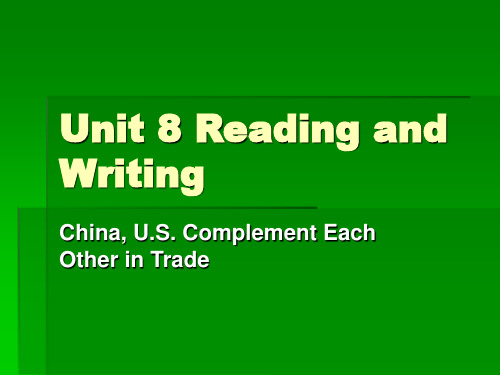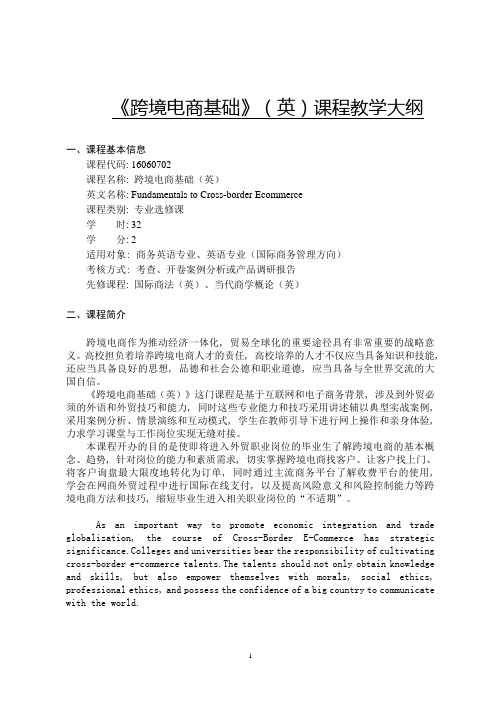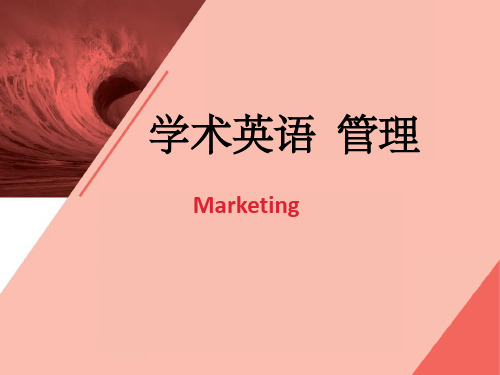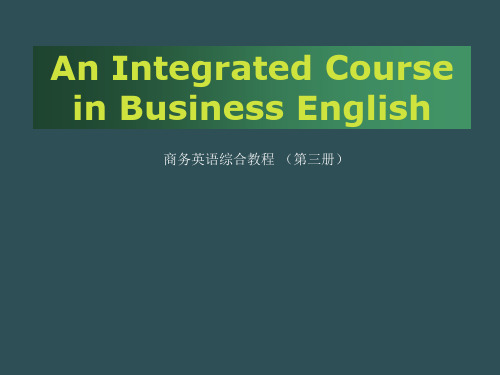unit2international marketing
- 格式:ppt
- 大小:1.51 MB
- 文档页数:41

Chapter 1&2:1.Market: anywhere that people with the desire and ability can buy a specific product.2.Market Segments (细分市场): 1) smaller groups of markets with potential customers thathave a great deal in common; 2) specialized set of goods or services may be provided3.T arget Market (目标市场): One or more specific groups of potential customers towardwhich an organization directs its marketing program.4.Marketing(市场营销定义): the process of building lasting relationships through planning,executing and controlling the conception, pricing, promotion and distribution of ideas, goods and services to create mutual exchanges that satisfy individual and organizational needs and objectives5.What four factors are needed for marketing to occur?1)Two or more parties with unsatisfied needs2) a desire and ability on their part be satisfied3) a way for the parties to communicate4)something to exchange.6.Marketing Mix (4Ps)(营销组合): the marketing mix is product, price, promotion, and place.7.Marketing’s T wo T asks:1)discovering consumer needs;2)satisfying consumer needs8. Marketing & Sales (市场营销与销售):1) Marketing is the process to persuade potential customers to buy a particular product orservice;2) Sales is the end result of the marketing process and occur when goods or services aregiven over to a customer in exchange for money or another valuable consideration.3) Marketing describes the whole commercial process that creates the interest that thepotential customer demonstrates prior to a sale. Sales transactions are the goal of marketing and serve as the basis for the relationship between the marketer and the consumer.4) An Example: "... if the circus is coming to town and you paint a sign saying 'CircusComing to the Fairground Saturday', that's advertising. If you put the sign on the back of an elephant and walk it into town, that's promotion. What you’ve done is marketing. If the town's citizens watch the circus, you show them the many entertainment booths, explain how much fun they'll have spending money at the booths, answer their questions and ultimately, they spend a lot at the circus, that's sales.9. Marketing Functions (市场营销功能):1) Contact: seeking out of prospective consumers2) Merchandising: the process of bringing the right product to the right place at the righttime in the right quantity at the right price3) Pricing: the determining factor when a purchase is made and is a key to profit.4) Promotion: support marketing efforts (paid advertising, personal selling, public relations,and supplemental efforts.5) Distribution (distribution channels): the process of putting the consumer and the producttogether.6) Human Resources (HR)10. Hierarchy of Effects (效果层级理论):1) Marketing term for the sequence of five steps by which consumers receive and use information in reaching decisions about what actions they will take.2) from the initial exposure to a product or advertisement to the purchase decision: (1) awareness (产品知名度), (2) affinity (产品关联), (3) preference (产品偏好), (4) confidence (产品信心), and (5) purchase (产品购买)Hierarchy of Effects43ConfidencePreferenceAffinity (Linking)Awareness PurchaseDOFEELTHINK11. Market: anywhere that people with the desire and ability can buy a specific productMarketplace: a location where goods and services are exchanged12. International Marketing (国际市场营销):1) International Marketing involves the firm in making one or more marketing mixdecisions across national boundaries. (Narrow Sense)2) International Marketing involves the firm in establishing manufacturing facilitiesoverseas and coordinating marketing strategies across markets. (Broad Sense)13. Characteristics of the International Marketing:1) Bigger market and Stronger Competition2) Huge Complexity of organizations3) Different Standards among Countries4) Higher Risk and More Difficulties14. Different Levels of Marketing (不同层次的市场营销):1) Domestic Marketing (国内营销): targeting exclusively on the home country market2) Export Marketing (出口营销): the first stage of addressing market opportunities outside the home country3) International Marketing (global marketing)(国际营销): the stage when a marketer enters certain countries according to a company’s resources and the nature of opportunit ies and threat 国际市场营销学8The International Marketing Task7 3. Economy Environmental uncontrollables country market AEnvironmental uncontrollables country market B Environmental uncontrollables country market C1. Competition1. Competition2. Technology Price Product Promotion Place or Distribution6. Geography and Infrastructure Foreign Environment(Uncontrollables)7. Structure ofDistribution 3. Economy 5. Political-LegalDomestic environment(Uncontrollables)(Controllables) 2 .Technology 4. Culture5. Political-Legal 4. CultureTarget Market15. International Marketing Process (国际市场营销过程): 10Appraising the international marketing environment (marketassessment)Deciding whether to go abroad (market orientation)Deciding which market to enter (market orientation)Deciding how to enter the market (strategy development)Deciding on the marketing mix (implementation)Deciding on the marketing control and management(control)16. How to enter overseas markets in the first place?1) Indirect export : exporters use an intermediary, such as an export agent, to deal withbuyers in the overseas markets.2) Direct export : companies handle their own exports, for example by setting up overseassales offices.3) Licensing : companies sell the rights to use a manufacturing process, trademark or patentfor a fee or royalty.4) Joint venture : two companies, for example an overseas firm and a local one, may worktogether to develop a particular market.5) Direct investment : the company buys a local firm, or sets up its own manufacturingsubsidiaries. 17. Regulation: principle or rule employed in controlling or managing the exports. 18. Financing: a firm fills the need for cash from external or borrowed money19. hard currency (硬通货):1) Stable , convertible currency (such as the Euro , US dollar , or Y en) or that enjoys the confidence of investors and traders alike2) Hard currencies serve as means of payment settlements because they do not suffer from sharp exchange rate fluctuations.20. soft currency (软通货): Currency belonging to a small, weak, or wildly fluctuating economyand which, therefore, is not in favor with foreign exchange dealers Chapters 2,3 & 4:1. Segmentation, T argeting, and Positioning (STP): Building the Right Relationships withthe Right CustomersMarket Segmentation (市场细分): dividing a market into distinct groups of buyerswith different needs, characteristics, or behavior who might require separate products ormarketing mixesSegmenting Consumer Markets (市场细分标准):Geographical segmentation (地理细分): World / Country Region , State / Province,City / Country, Neighborhood, Climate, GeographyDemographic segmentation (人口细分): Most popular segmentation Age / Gender,Family size, Family life cycle, Income / Occupation, Education ,Religion / Race,NationalityPsychographic segmentation (心理细分): Lifestyle, Social classBehavioral segmentation (行为细分): User status, Usage rates, Loyalty status● Market T argeting(目标市场选择): the process of evaluating each market segment’sattractiveness and selecting one or more segments to enter.Segmentation & T argeting Strategies :Mass marketing (Undifferentiated marketing) (无差异性营销): offering the sameproduct to the entire consumer population (entire market) 企业只推出一种产品,只用一套营销办法招徕所有顾客。



《跨境电商基础》(英)课程教学大纲一、课程基本信息课程代码: 16060702课程名称: 跨境电商基础(英)英文名称: Fundamentals to Cross-border Ecommerce课程类别: 专业选修课学时: 32学分: 2适用对象: 商务英语专业、英语专业(国际商务管理方向)考核方式: 考查、开卷案例分析或产品调研报告先修课程: 国际商法(英)、当代商学概论(英)二、课程简介跨境电商作为推动经济一体化, 贸易全球化的重要途径具有非常重要的战略意义。
高校担负着培养跨境电商人才的责任, 高校培养的人才不仅应当具备知识和技能, 还应当具备良好的思想, 品德和社会公德和职业道德, 应当具备与全世界交流的大国自信。
《跨境电商基础(英)》这门课程是基于互联网和电子商务背景, 涉及到外贸必须的外语和外贸技巧和能力, 同时这些专业能力和技巧采用讲述辅以典型实战案例, 采用案例分析、情景演练和互动模式, 学生在教师引导下进行网上操作和亲身体验, 力求学习课堂与工作岗位实现无缝对接。
本课程开办的目的是使即将进入外贸职业岗位的毕业生了解跨境电商的基本概念、趋势, 针对岗位的能力和素质需求, 切实掌握跨境电商找客户、让客户找上门、将客户询盘最大限度地转化为订单, 同时通过主流商务平台了解收费平台的使用, 学会在网商外贸过程中进行国际在线支付, 以及提高风险意义和风险控制能力等跨境电商方法和技巧, 缩短毕业生进入相关职业岗位的“不适期”。
As an important way to promote economic integration and trade globalization, the course of Cross-Border E-Commerce has strategic significance.Colleges and universities bear the responsibility of cultivating cross-border e-commerce talents.The talents should not only obtain knowledge and skills, but also empower themselves with morals, social ethics, professional ethics, and possess the confidence of a big country to communicate with the world.This course, Fundamentals to Cross-border Ecommerce (English) is based on the Internet and e-commerce background.It involves the foreign language and foreign trade skills and abilities necessary for foreign trade.At the same time, these professional abilities and skills are supplemented by typical practical cases and case studies.Situational exercises and interactive modes, students conduct online operations and personal experience under the guidance, and strive to achieve seamless integration between classrooms and future jobs.The purpose of this course is to enable the seniors who are about to enter foreign trade careers to understand the basic concepts and trends of cross-border e-commerce, to meet the ability and quality needs of the relative posts, to effectively grasp the concept and process of cross-border e-commerce to find customers actively, to be found by the potential business partners by some passive marketing, mainly via the mainstream cross-border electronic commercial platforms.Then to maximize the possibility to transform customers’inquiries and requirements into real orders is another vital concern.The use of toll platforms is understood through the mainstream business platform.International online payment is taught in the process of foreign trade of online merchants, and cross-border e-commerce methods and techniques such as improving risk significance and risk control capabilities are shortened.Graduates enter the “discomfort period”of relevant professional positions. Course assessment is based on the weighted average of class participation 40% and final term case analysis 60%.Marks for class participation will be determined by five parts --- students’in-class group presentation, group case discussion, and individual in-class question-answering, written assignment and class attendance.三、课程性质与教学目的《跨境电商基础(英)》是外国语学院为商务英语专业以及英语专业(国际商务管理方向)学生开设的专业选修课。


商务英语Unit2参考答案Unit 2 BrandsPart I Business V ocabularyDirections: There are 20 incomplete sentences in this part. For each sentence there are four choices marked A, B, C and D. Choose the ONE that best completes the sentence. Then mark the corresponding letter on the Answer Sheet with a single line through the center. This part totals 20 points, one point for each sentence.C1 A brand can be a name, a term or a symbol. It is used to ______________ a product from competitors’ products.A differB competeC differentiateD compareB2 Brands should add value to products. It’s a _______________ effect whereby one plus one equals three.A energyB synergyC coordinationD collaboration D3 The better-known the brand name, the more people want to _______ it _______.A copy…offB send…offC break…offD rip…offA4 In the past Calvin Klein took a relatively passive _______________ to the counterfeit problem.A approachB methodC wayD modeB5 But as sales and brand ________________ have risen, Calvin Klein has become an increasingly popular target for Asian and European counterfeiters.A imageB awarenessC managementD loyaltyD6 I’m worried about the sales of the range of fragrances we ________________ two years ago.A soldB mountedC impoundedD launchedB7 The advert stated – jokingly – that 7 million points were needed for someone to ____________ the jet.A declareB claimC announceD specifyB8 A business student, John Leonard, intends to take Pepsi Cola to_______________ regarding the promotion because he thinks they should give him the prize.A homeB policeC schoolD officeD9 Customers have become less loyal to brands and are more willing to____________ to lower-priced coffee products.A trade inB trade forC trade upD trade downC10 It is ________________ as an exclusive ground coffee for gourmets.A producedB madeC promotedD soldA11 Thank you for the _____________ order of February 2 for 28,800 raincoats.A captionedB captioningC to captionD captionC12 Y our order will be ready for shipment by February 28 and be packed _________ seaworthy containers.A byB throughC inD withinD13 Our raincoats are now packed in a polythene bag each and then in a cardboard box, 12 dozen ______________ a carton.A inB atC14 Each carton is ____________ with a polythene sheet and secured by overall strapping.A liningB lineC linedD to lineB15 In addition, the packing is light ________ weight and therefore easy to handle.A toB inC atD forA16 Since a polythene bag is used for each raincoat, it is attractive and _________ for window display.A all readyB alreadyC all readinessD readinessB 17 ____________ regard to packing in cartons for your order, we would like to give you our comments as follows.A AsB WithC ForD AtA18 Cartons lined with plastic sheets can be well protected ____________ moisture, for they can be secured by overall strapping.A againstB forC byD throughC19 Since the trace of pilferage is ___________ more evident, it is easier to file a claim against the insurance company.A manyB lotC muchD fewerB20 Therefore, cartons are convenient ____________ handle and quite suitable for ocean transportation.A forB toPart II Phrase Translation 1 国际品牌International brand2 民族品牌National brand3 品牌商品Branded goods4 品牌管理Brand management5 ⾼档品牌luxury brand6 经典品牌Classic brand7 品牌知名度Brand awareness8 品牌形象Brand image9 品牌忠实Brand loyalty10 品牌延伸Brand stretching11 物有所值V alue for money12 公司战略Corporate strategy13 许可权利Licensing right14 时装设计师Fashion designer15 快餐公司Fast food company16 ⼴告宣传活动Advertising campaign17 研磨咖啡Ground coffee18 市场份额Market share19 消费者调查Consumer survey20 细分市场market SegmentPart III Sentence Translation1.The aim of the advertising campaign is to enhance brand awareness so thatconsumers become more familiar with our coffee products.⼴告宣传活动的⽬的是提⾼品牌知名度以便于消费者更加熟悉我们的咖啡产品。